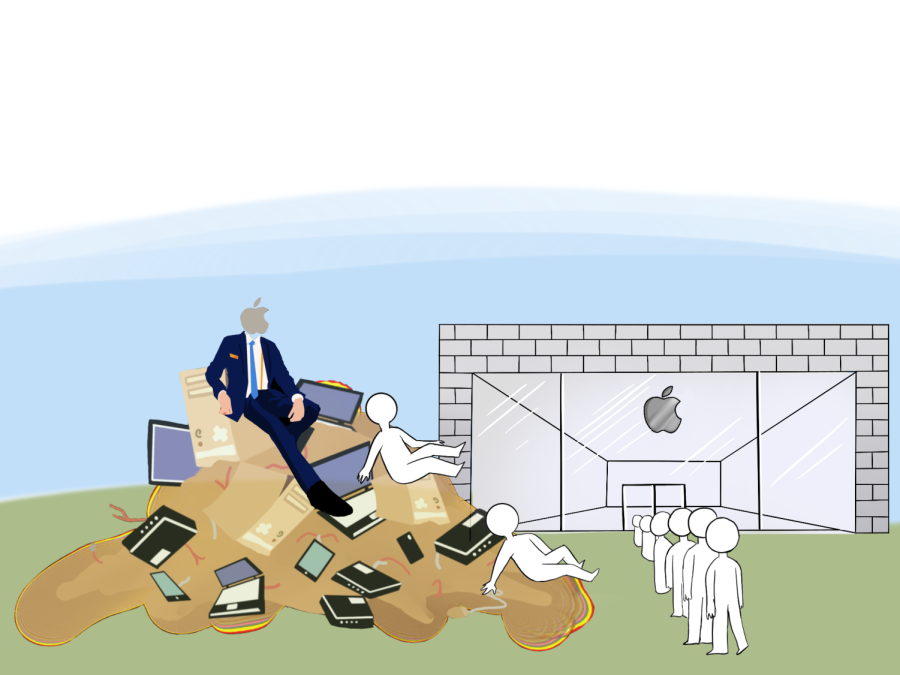Pushing back on planned obsolescence
Apple sitting on top of a pile of discarded electronics, as consumers drone mindlessly towards the Apple Store to buy the latest new shiny IPhone and discard the old.
October 10, 2022
Whenever a new iPhone comes out, Instagram feeds are flooded with “Holding my new baby” posts. For some, upgrading to the newest version is like gifting themselves a new toy. However, a growing portion of consumers is being forced to upgrade after only a few years due to planned obsolescence, or the practice of creating products with a limited lifespan or introducing products so frequently that customers are compelled to purchase an “improved” version. Over time, older versions of products deemed out of date begin to perform poorly. Not only does planned obsolescence increase electronic waste, but it creates a cycle of low-quality products that promote overconsumption. While the only option may seem to be regulatory action by the federal government, consumers should take a more active part to combat planned obsolescence.
One of the most widely cited examples of planned obsolescence begins with lightbulbs and the formation of the Phoebus Cartel. By the early 20th century, commercial light bulbs’ lifespan continued to climb every year due to rapid innovations in filament material, from 14 hours in 1872 to nearly 2,500 hours in the 1920s. However, the companies manufacturing them soon realized that producing better light bulbs would result in lower profits. Together, they formed the Phoebus Cartel and worked together to control the world’s supply of light bulbs by limiting lifespans to 1,000 hours, thereby forcing customers to buy more. As expected, sales went up 25% in the following years.
“The Phoebus Cartel is a story of limiting how much durability was built into the light bulb,” said Michael Waldman, Professor of Management and Economics at Cornell University. “The textbook market, for example, is more concerning the idea of frequent new product introductions.”
This storied history paved the way for issues in the present day. In 2021 alone, Apple spent millions of dollars to settle planned obsolescence lawsuits against its iPhones in the U.S.. By purposefully throttling performance and lifespan on older devices, tech companies like Apple are unnecessarily forcing upgrades onto consumers.
“In ninth grade, I had an iPhone 6,” senior Aneesha Jobi said. “After 10 months of usage, the battery had an issue where it would charge completely, then drop down to 2% after a few minutes of use.”
An often overlooked aspect of planned obsolescence is the gradually diminishing right to repair. Whenever a product is taken to an official store for repair, the usual response would be to get the newer product because an upgrade would cost the same amount as a repair. The right-to-repair movement has called for companies to provide customers with the means to repair devices on their own or go to lower-cost independent repair shops.
“It saves you money if you can fix it, but companies lose the ability to sell you another version of the product,” English teacher David Clarke said.
Among critics, the largest concern over planned obsolescence is its environmental impact. Besides planned obsolescence causing tech products to be increasingly replaced and thrown out each year, consumers’ desires to get the hottest product on the market also play a role. Moreover, tech products are often improperly disposed of, leading to toxic electronic waste spreading through landfills and poisoning our water, air and soil. Consumers discarded an estimated 63.3 million tons of electronic waste in 2021, enough to outweigh the Great Wall of China.
“It is very distressing to watch how much stuff is thrown away,” Clarke said. “The amount of time and labor that goes into extracting limited raw materials to produce these various products, just for them to be tossed away. That is a very inefficient way to run a society.”
Proponents believe planned obsolescence should stay unregulated because it promotes research and development in technology. They argue that it provides a reason for companies to create new products to meet customer demand for better products each year. In addition, many are still adamant that the government should not interfere in free market activities. Although planned obsolescence benefits businesses and generates cash flow to satisfy investors, the harms heavily outweigh the benefits.
One solution is for regulatory action to be taken by the U.S. federal government to mitigate the effects of planned obsolescence. In 2015, France became the first country in the world to define the practice of planned obsolescence and outlaw it. These regulations have successfully created a platform to vocalize complaints and spur further litigation. Despite the success in France, the U.S. still has no federal laws regulating the practice. Furthermore, many argue that a U.S. ban on planned obsolescence would be near impossible to enforce.
“If you wanted to regulate planned obsolescence, I think that the right to repair might be the way to go about it,” Waldman said. “Regulation on that dimension is more feasible than some of the other regulations I could imagine people trying to pass.”
More importantly, the immediate solution is for consumers to take action. If there is an option to repair a product, take the opportunity instead of disposing of it. If the disposal is necessary, consumers must make sure electronics are disposed of properly to prevent further damage to the environment. Moreover, consumers must resist the urge to replace tech products every year. Consumerist tendencies and the fear of missing out whenever a flashy new product, like the brand new iPhone comes out, are not excuses. If there is no urgent need for a new version of a product, do not buy it. Take action to protest and lobby for the right of repair against companies who partake in planned obsolescence. Now is the time to start fighting to make planned obsolescence obsolete.


































































